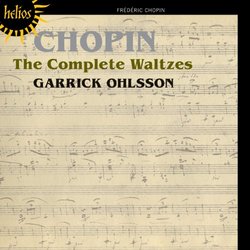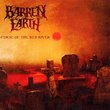| All Artists: Garrick Ohlsson Title: Chopin: Complete Waltzes Members Wishing: 0 Total Copies: 0 Label: Hyperion Original Release Date: 1/1/2010 Re-Release Date: 1/12/2010 Album Type: Import Genres: New Age, Classical Styles: Instrumental, Historical Periods, Classical (c.1770-1830) Number of Discs: 1 SwapaCD Credits: 1 UPC: 034571153810 |
Search - Garrick Ohlsson :: Chopin: Complete Waltzes
 | Garrick Ohlsson Chopin: Complete Waltzes Genres: New Age, Classical To celebrate the 200th anniversary of Chopins, Hyperion has excerpted some of the finest performances from Garrick Ohlsson's complete Chopin project, originally recorded for the Arabesque label and reissued on Hyperion as ... more » |
Larger Image |
CD DetailsSynopsis
Product Description To celebrate the 200th anniversary of Chopins, Hyperion has excerpted some of the finest performances from Garrick Ohlsson's complete Chopin project, originally recorded for the Arabesque label and reissued on Hyperion as a 16-CD boxed set. These discs include some of the finest contemporary Chopin playing and include definitive performances of the complete etudes and mazurkas. Similar CDs
|
CD Reviews(+) The Chopin Waltzes as Deep and Dark as You Ever Heard Th C. Pontus T. | SE/Asia | 01/17/2010 (4 out of 5 stars) "As a young man, I found Chopin's Waltzes very approachable and pianistically rewarding (did play a number of them myself). However, with age I seem to revisit these Viennese sweets increasingly seldom. I believe the reason is twofold: they are the least profound genre pieces in the Chopin oeuvre, if with a number of important exceptions; and they are very hard to bring off as a whole, something that perhaps no pianist has fully mastered on disc.
As to the former issue, Ohlsson is likely the most persuasive proponent on record to convince us that the Waltzes do contain depth and darkness like the Mazurkas, and that some even approach tone poems like the Polonaises; before Ohlsson, Alexeev adopted a similar approach in the mid-1980s and succeeded almost as well. Indeed, Op 34/2, Op 64/2, Op 69 and Op 70/2 all come out as deeply dark as any of the great Mazurkas--miles away from the pompous ballrooms of Vienna and Paris. Furthermore, Op 34/1 is given such a large-scale and poetic performance that calling it a tone poem would not be an exaggeration (Ohlsson seems to have special feelings for this piece and even, which is a rare exception in his complete survey, adds a number of notes in the upward figurations just before the Coda). So far so good; nonetheless, to these ears it does not matter how much beauty and refinement are induced in Op 18, Op 34/3, Op 42, Op 64/1 and Op 70/1--for better or for worse, they are still brilliant showpieces. It is in the area of brilliance that Ohlsson falls somewhat short of the versions by Ashkenazy, Harasiewicz and Lipatti--although I have to confess to never having quite understood the widespread praise for the latter whose brilliance, much like Rubinstein's, seems mostly confined to the surface of the Waltzes. As a superficial comparison, Ashkenazy uses 55 minutes and 46 seconds to get through all 19 Waltzes, whereas Ohlsson uses 67:28--on average more than 40 additional seconds per Waltz. (Alexeev clocks in at 65:50.) It should be noted, though, that Ohlsson surprises by giving one of the most outwardly delectable accounts of the 'Minute' Waltz on disc. As a consequence of the aforesaid, my ideal Chopin Waltzes would consist of some 60% Ohlsson and some 40% Ashkenazy (Ohlsson is, as so often in his complete survey, marvellous at making the early posthumously published Waltzes sound like vintage gems). This disc was recorded by Arabesque in November 1995, in the sumptuous acoustics of the SUNY Performing Arts Center--and the Bösendorfer Imperial Grand sounds even more appropriately rich in this pronouncedly Viennese repertoire. Around the same time, Perahia recorded near-ideal accounts of Op 18 and Op 42 (I have always found Perahia best in lighter repertoire), whereas Kissin at 21 gave live performances at Carnegie Hall of Op 34/1, Op 34/2 and Op 42 that are beyond reproach. In more recent years, three complete sets have appeared on the bigger labels--from Tharaud (HM, 2006), Fliter (EMI, 2009) and Ott (DG, 2010). Judging from the extensive samples available online, none of them even remotely rival Ohlsson's reflective beauty or Ashkenazy's stylish brilliance; Tharaud is the one that may be worth seeking out for his refined (if seemingly laboured) thoughtfulness, whereas Filter sounds rather pedestrian (neither particularly beautiful nor brilliant), and Ott seems largely lost in her excessive and immaturely erratic rubato. This Helios reissue not only includes a 20th Waltz in F-sharp minor--published in 1932 by Maurice Dumnesnil, who claimed an old Spanish priest gave him a copy of it, 'the most previous of his possession', allegedly originating from Chopin & Sand's infamous stay at Valdemosa in 1838--which sounds little more than a Waltz than the Nocturnes in 3/4 measure; it also offers the Contredanse and the three Ecossaises as gorgeously sparkling bonuses in the hands of Ohlsson. Next out is the mature Polonaises (Helios CDH55382). REFERENCES: This One, Ashkenazy" |



